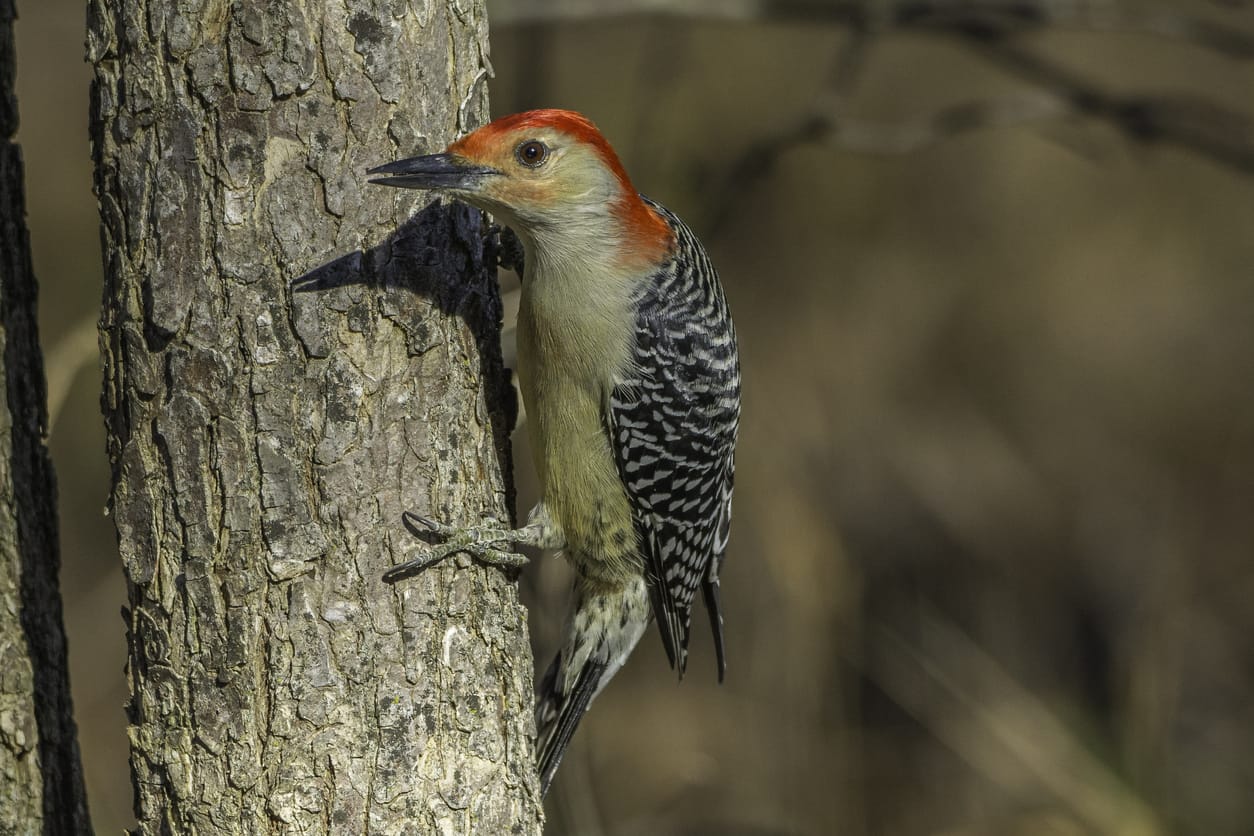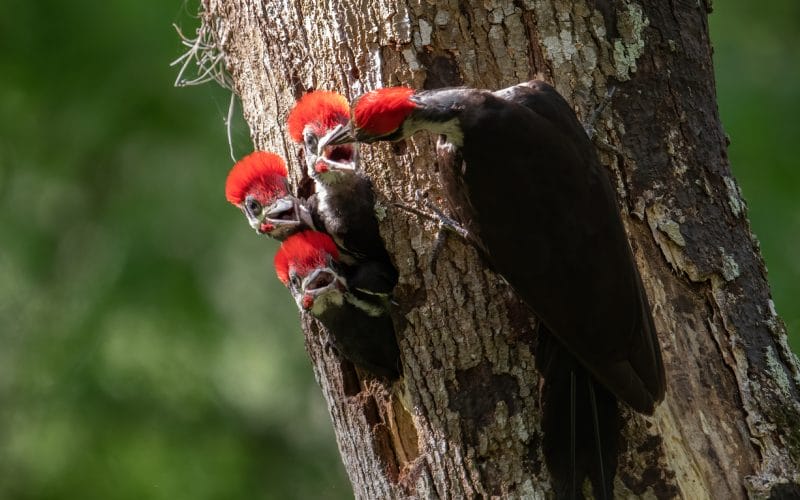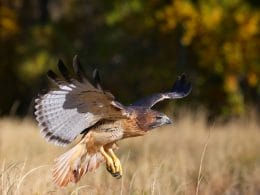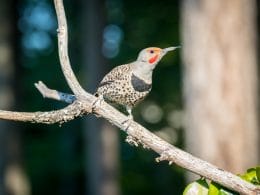Georgia is blessed with diverse habitats and physical features, making it attractive to more than 340 bird species.
Not all of them are permanent residents of the state, of course. These species include summer-breeding birds, winter residents, and even visitors that stop for some time during their migration journeys.
In this article, we’ll be focusing on the woodpecker species that you can find in Georgia. Woodpeckers are interesting birds and, luckily, you can find several of them in the state.
So, keep on reading to get to know the eight species of woodpeckers in Georgia.
8 Species of Woodpeckers in Georgia to Watch For
Here’s a list of the eight woodpeckers you can find in Georgia. We also included a ninth species that’s almost certainly extinct, which is the Ivory-billed Woodpecker.
1. Red-bellied Woodpecker

- Scientific Name: Melanerpes carolinus
- Length: 8 to 9.5 in
- Weight: 2.0 to 3.0 oz
- Wingspan: 13 to 16.5 in
Despite their names, Red-bellied Woodpeckers don’t have prominent red bellies. Instead, they have pale red color on their bellies, while the pronounced red color is on their crests and napes.
Females only have red napes, while males have both red crests and napes. Besides their red color, both sexes have distinctive black-and-white striped backs with white patches near their wingtips.
Red-bellied Woodpeckers are common in Georgia as they’re permanent residents of the state. They like nesting in woodlands and forests, but you can also see them in residential areas.
Author Note: These medium-sized birds are common visitors to bird feeders, especially if these backyards are near wooded patches or include dead trees. You can attract them to your backyard using peanuts, sunflower seeds, and suet.
When not feeding from feeders, these woodpeckers forage, searching for insects. They also like to climb trees picking up berries and nuts.
What’s fascinating about Red-bellied Woodpeckers is their ability to stick out their tongues two inches past the end of their peaks. Additionally, the tip of their tongues is barbed, and their spit is sticky. This makes them skillful at picking up insects from deep cervixes.
2. Yellow-bellied Woodpecker
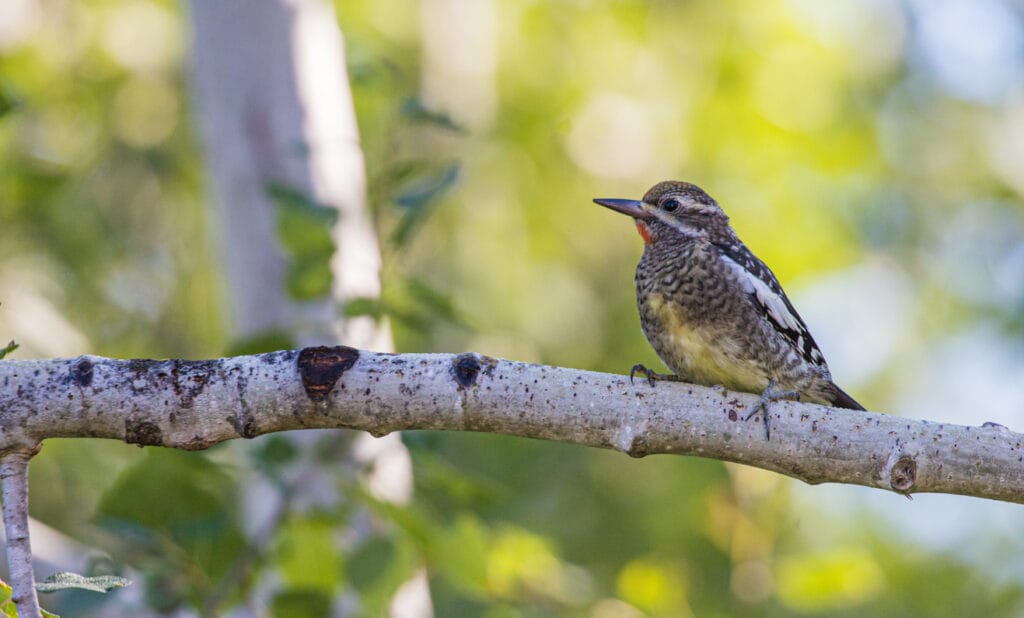
- Scientific Name: Sphyrapicus varius
- Length: 7.0 to 8.0 in
- Weight:1.5 to 2.0 oz
- Wingspan: 13 to 16.5 in
Yellow-bellied Woodpeckers are known for having a sweet tooth. They’re characterized by having stout, strong bills that allow them to drill holes in trees looking for sap.
They like to feed on any insects that are attracted to the sap. They also eat cambium and other tree tissues, as well as berries and nuts.
To identify these small woodpeckers, look for bold black-and-white stripes on their faces that extend to their backs. Besides, keep an eye for yellowish bellies, as the name suggests.
Both sexes have red foreheads, while only males have red throats.
Yellow-bellied Woodpeckers are migratory birds, so they’re rarely seen in the state during their breeding season. Otherwise, they’re common in all areas of Georgia, especially in the northeastern parts.
These birds live in high elevations in hardwood and conifer forests. They specifically prefer nesting in smaller trees like aspens.
To increase your chances of seeing these beautiful woodpeckers, look for them in open woodlands or try to attract them to your backyard with some suet.
3. Downy Woodpecker

- Scientific Name: Dryobates pubescens
- Length: 5.5 to 7 in
- Weight: 0.74 to 1 oz
- Wingspan: 3.0 to 12 in
The Downy Woodpecker is the smallest in North America. Therefore, it can reach foods that larger woodpeckers can’t.
This woodpecker is black-and-white overall, with white spots on the wings and a broad white stripe down the center of the back. Also, it has a black-and-white striped face and a white underpart.
Males have a red patch on the back of their heads that females lack.
You can see the Downy Woodpecker hanging out around tree trunks and limbs, searching for insects. It also likes to drop down and eat bugs found in tall weeds.
With its small, straight bill and acrobatic movements, this tiny woodpecker can hammer on goldenrod galls to feed on the larvae. Besides insects, the Downy Woodpecker eats berries, seeds, and suet.
Author Note: Downy Woodpeckers are permanent residents of Georgia and can be found nearly everywhere in the state. They love visiting backyard feeders and might nest inside building walls. Just put out some suet for them, and a Downie might visit your property.
Plus, you can look for them in parks, orchards, vacant lots as well as open woodlands.
What sets Downies from other woodpeckers is that they’re fairly vocal. Besides their drumming noises, they make lots of shrill whinnying calls.
4. Hairy Woodpeckers

- Scientific Name: Dryobates villosus
- Length: 7 to 10 in
- Weight: 1.5 to 3.5 oz
- Wingspan: 13 to 16 in
It’s hard to identify Hairy Woodpeckers as they look very similar to Downy Woodpeckers. They’re like identical twins, but the Hairy is larger.
The size doesn’t really help with identification unless they’re right next to each other. However, what really gives them away is the softness of their feathers.
Downies have softer, more fluffy feathers overall, but they’re more prominent on the back of their heads. On the other hand, Hairies have more stiff and bristly feathers.
Also, Downies have shorter bills while Hairies have bills that are almost the size of their heads. Overall, Hairy woodpeckers have a soldierly look.
You can find Downies and Hairies occupying the same areas. Hairies take larger tree trunks while Downies forage on smaller branches. Hairies also like to appear in areas where other woodpeckers are present. They live off of Pileated woodpeckers’ and sapsuckers’ hard work.
When a Pileated Woodpecker drills holes searching for food, then moves on, a Hairy woodpecker will visit the same hole to eat insects that the Pileated Woodpecker missed. The same goes for holes left by sapsuckers.
If you want to spot Hairy Woodpeckers, consider taking a trip to open woodlands where oak and pine trees are found. Also, look for them in suburbs, parks, and recently burned forests.
You can draw them to your backyard with suet, black oil sunflower seeds, and peanuts. There’s an even greater chance for them to visit your backyard in winter when food is scarce.
5. Pileated Woodpecker
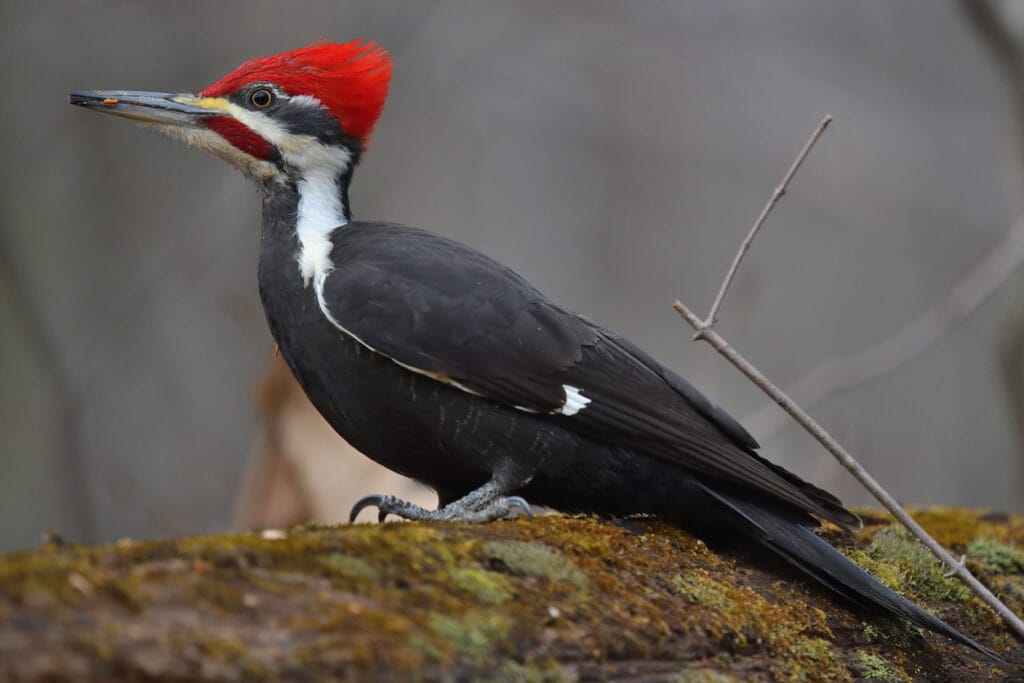
- Scientific Name: Dryocopus pileatus
- Length: 16 to 19 in
- Weight: 9 to 12 oz
- Wingspan: 26 to 30 in
The Pileated Woodpecker is the largest in North America. Its big size and broad wings make it look crowlike.
It’s easy to identify Pileated woodpeckers with their long necks and flashing-red triangular crests. They’re mostly black with white stripes on their faces and white underwings.
Pileated Woodpeckers are extremely strong. They drill broad and deep excavations that might cause some trees to break in half.
You can easily differentiate their feeding excavation from other woodpeckers’. Pileated Woodpeckers specifically drill rectangular holes looking for ants. Many other birds and woodpeckers later use these holes to look for food.
Author Note: It’s not the easiest thing to spot Pileated Woodpeckers as they’re forest birds that require large, standing trees. They’re also not frequent visitors to backyard feeders.
However, you can still attract one with some suet, or you could leave dead or dying trees for them. If you want to have the attention of a mating pair, consider setting up a nesting box.
Pileated Woodpeckers are permanent residents of Georgia, but they’re more common in the southwest part of the state.
6. Northern Flicker

- Scientific Name: Colaptes auratus
- Length: 12.0 to 14.0 in
- Weight: 4 to 6 oz
- Wingspan: 16.5 to 21 in
The Northern Flicker is the second-largest woodpecker in Georgia. It used to be Georgia’s most common woodpecker, but unfortunately, its numbers have declined over the decades due to habitat loss.
This is something that’s cause for concern. Luckily, you can still see this woodpecker everywhere in the state, from mountain forests to parks and yards.
Unlike all other woodpeckers in Georgia, the Northern Flicker is brownish overall with black spots, crescents, and bars all over its plumage.
Two forms of the Northern Flicker are common in North America: Red-shafted and Yellow-shafted Northern flickers.
The Northern Flicker that you’ll usually find in Georgia is the Yellow-shafted one. As the name suggests, the underside of the wings and tails of this woodpecker is bright yellow.
Another thing that is different about Northern Flickers is that they prefer searching for food on the ground.
Ants make up most of their diet, but they don’t just feed on ants. They also rub them on their bodies. The formic acids in the ants help fight small parasites that might infest the birds’ beautiful plumage.
Besides ants, these birds eat berries, seeds, and fallen fruits. They might give your backyard a visit looking for berries and fruits and maybe use your birdbaths.
7. Red-headed Woodpecker

- Scientific Name: Melanerpes carolinus
- Length: 7.5 to 9.5 in
- Weight: 2.0 to 3.0 oz
- Wingspan: 13 to 16.5 in
The Red-headed Woodpecker is another woodpecker that’s in decline due to habitat loss.
It loves living in pine savannas and other open forests. It’s also attracted to tree rows in agricultural areas, standing trees in swaps, and other wetlands, as well as open pine plantations.
Despite the severe decline in its numbers, the bird is still common in Georgia as it’s a permanent resident of the state.
Red-headed Woodpeckers are among the easiest birds to identify with their bright red heads. They have pure white underparts with black backs and white patches on the wings.
Top Tip: Their distinctive color pattern earned them many nicknames including, “half-a-shirt,” “the flying checker-board,” and “flag bird.”
Similar to all woodpeckers, Red-headed Woodpeckers catch insects by hammering at the wood. However, they also catch insects in flight and on the ground.
Top Tip: In addition, they like eating fruits and seeds, such as raspberries, strawberries, cherries, blackberries, and apples.
While they’re not frequent visitors to backyard feeders, you might be successful at attracting one with some suet, especially in the winter.
These woodpeckers are among the only four woodpeckers in North America that are known to store food. Yet, they’re the only woodpeckers that cover their food with bark or wood.
8. Red-cockaded Woodpecker
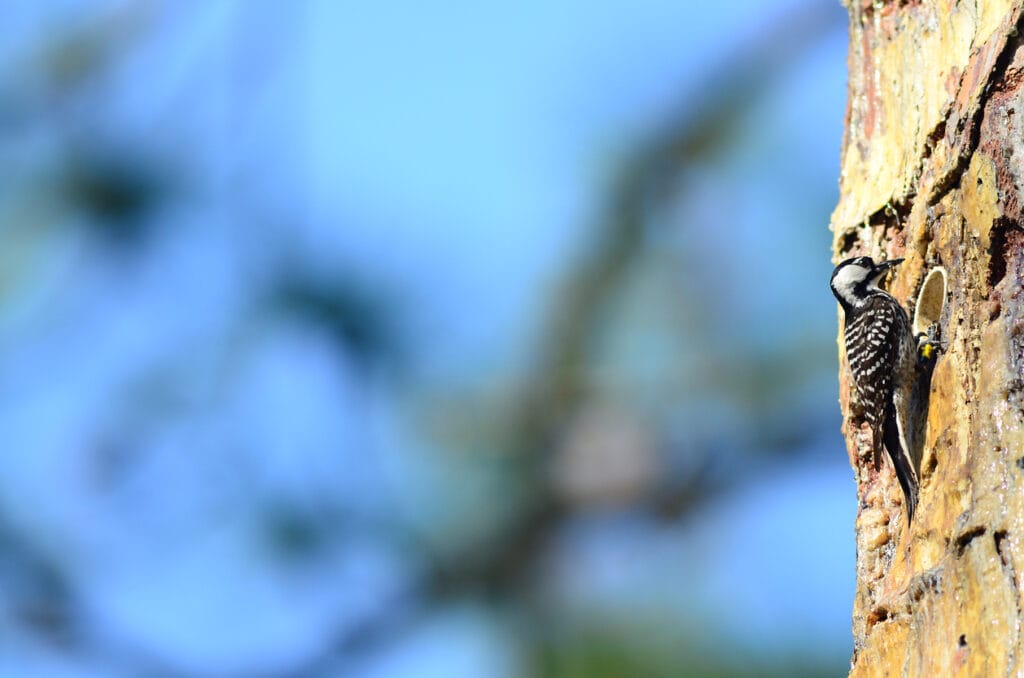
- Scientific Name: Dryobates borealis
- Length: 8.0 to 9.0 in
- Weight: 1.5 to 2 oz
- Wingspan: 13.5 to 15 in
Even though their name calls for red on their plumage, they don’t really have scarlet-colored feathers. Red-cockaded Woodpeckers are black-and-white overall with white cheek patches.
The rest of their bodies have black-and-white spots, bars, and stripes. So, why do they have this name?
It’s because the male Red-cockaded Woodpecker has a tiny red streak or cockade on its upper cheek behind the eyes.
Red-cockaded Woodpeckers are actually hard to spot as they prefer very specific habitats, which is the cause of their major number decline.
These woodpeckers only roost and nest in pine forests or, as an alternative, in pine flat woods. They prefer trees that are infected with red heart fungus. This infection softens the wood, making it easier for them to drill their excavations.
Something that proves the intelligence of Red-cockaded Woodpeckers is their defense mechanism against tree-climbing snakes. The birds drill sap wells next to their nests so that these drills make it harder for snakes to climb up.
Georgia is lucky enough to be one of the states in which you can find this woodpecker. Its range extends mostly to the southern and central areas of the state.
9. Ivory-billed Woodpecker
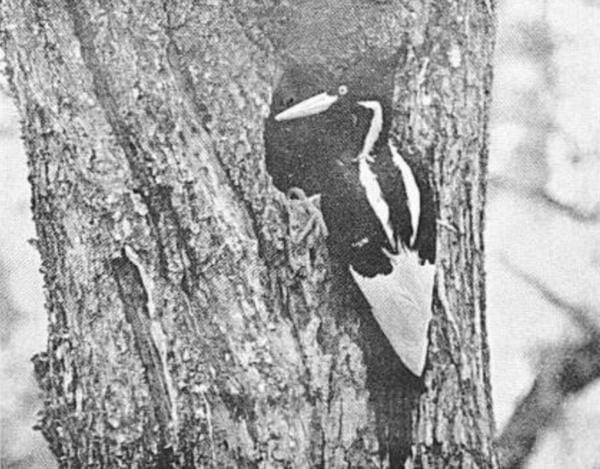
- Scientific Name: Campephilus principalis
- Length: 18 to 20 in
- Weight: 16 to 20 oz
- Wingspan: 30 to 31.5 in
The Ivory-billed Woodpecker was the largest in North America. It was a bit larger than a crow with a heavy, straight bill, straight crest, and a long neck.
It was black with two white stripes down the neck and broad white patches on the wings. Males had red crests while females had black crests. The name Ivory-billed came from the fact that box sexes had pale bills.
While Ivory-billed Woodpeckers are extinct, they’re still worth mentioning as they once called Georgia their home.
Author Note: Similar to the Red-cockaded Woodpecker, the Ivory woodpecker was a habitat specialist. It preferred open forests with large trees and upland pine forests.
Due to the destruction of its habitat, its numbers severely declined through the 1800s, and a small number barely made it to the twentieth century.
The species was rediscovered in 2004 in Arkansas, and there have been many attempts to relocate the bird in the southeastern U.S.
Wrapping Up
Here you have it, the eight woodpeckers you can see in Georgia. Luckily, almost all of them are permanent residents of the state and are quite common.
We also included an honorable mention of the extinct Ivory-billed Woodpecker to remind ourselves of the importance of protecting our birds and our ecosystems.
FAQ
Take a look at our descriptions. There are lots of woodpeckers that are commonly seen in Georgia. It is a great place to see them.
To find out where recent sightings of woodpecker have been, try eBird. You can search for the latest sightings or particular species or what has been seen in a certain area.
Try these places:
Harris Neck National Wildlife Refuge, Piedmont National Wildlife Refuge, E. L. Huie Land Application Facility and Newman Wetlands Center, Brasstown Bald.




